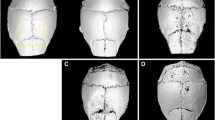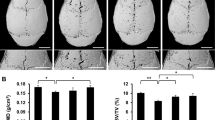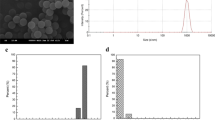Abstract
Purpose
Wear debris-induced osteolysis and aseptic loosening are the most frequent late complications of total joint arthroplasty leading to revision of the prosthesis. However, no effective measures for the prevention and treatment of particles-induced osteolysis currently exist. Here, we investigated the efficacy of local administration of osthole on tricalcium phosphate (TCP) particles-induced osteolysis in a murine calvarial model.
Methods
TCP particles were implanted over the calvaria of ICR mice, and established TCP particles-induced osteolysis model. On days one, four, seven, ten and thirteen post-surgery, osthole (10 mg/kg) or phosphate buffer saline (PBS) were subcutaneously injected into the calvaria of TCP particles-implanted or sham-operated mice. Two weeks later, blood, the periosteum and the calvaria were collected and processed for bone turnover markers, pro-inflammatory cytokine, histomorphometric and molecular analysis.
Results
Osthole (10 mg/kg) markedly prevented TCP particles-induced osteoclastogenesis and bone resorption in a mouse calvarial model. Osthole also inhibited the decrease of serum osteocalcin level and calvarial alkaline phosphatase (ALP) activity, and prevented the increase in the activity of tartrate resistant acid phosphatase (TRAP) and cathepsin K in the mouse calvaria. Furthermore, osthole obviously reduced the release of tumor necrosis factor-α (TNF-α) and interleukin-6 (IL-6) into the periosteum. Western blotting demonstrated TCP particles caused a remarkable endoplasmic reticulum (ER) stress response in the mouse calvaria, which was obviously blocked by osthole treatment.
Conclusion
These results suggest that local administration of osthole inhibits TCP particles-induced osteolysis in the mouse calvarial in vivo, which may be mediated by inhibition of the ER stress signaling pathway, and it will be developed as a new drug in the prevention and treatment of destructive diseases caused by prosthetic wear particles.





Similar content being viewed by others
References
Harris WH (2001) Wear and periprosthetic osteolysis: the problem. Clin Orthop Relat Res 393:66–70
Fu CF, Xie J, Hu N, Liang X, Chen RF, Wang CL, Chen C, Xu CM, Huang W, Paul Sung KL (2014) Titanium particles up-regulate the activity of matrix metalloproteinase-2 in human synovial cells. Int Orthop 38(5):1091–1098
Katsuyama E, Miyamoto H, Kobayashi T, Sato Y, Hao W, Kanagawa H, Fujie A, Tando T, Watanabe R, Morita M, Miyamoto K, Niki Y, Morioka H, Matsumoto M, Toyama Y, Miyamoto T (2015) Interleukin-1 receptor-associated kinase-4 (IRAK4) promotes inflammatory osteolysis by activating osteoclasts and inhibiting formation of foreign body giant cells. J Biol Chem 290(2):716–726
Vallés G, Pérez C, Boré A, Martín-Saavedra F, Saldaña L, Vilaboa N (2013) Simvastatin prevents the induction of interleukin-6 gene expression by titanium particles in human osteoblastic cells. Acta Biomater 9(1):4916–4925
Sundfeldt M, Carlsson LV, Johansson CB, Thomsen P, Gretzer C (2006) Aseptic loosening, not only a question of wear: a review of different theories. Acta Orthop 77(2):177–197
Wu SJ (2015) Osthole attenuates inflammatory responses and regulates the expression of inflammatory mediators in HepG2 cells grown in differentiated medium from 3T3-L1 preadipocytes. J Med Food 18(9):972–979
Wang XL, Shang X, Cui Y, Zhao X, Zhang Y, Xie ML (2015) Osthole inhibits inflammatory cytokine release through PPARα/γ-mediated mechanisms in LPS-stimulated 3T3-L1 adipocytes. Immunopharmacol Immunotoxicol 37(2):185–192
Li ZP, Ji HJ, Song XY, Hu JF, Han N, Chen NH (2014) Osthole attenuates the development of carrageenan-induced lung inflammation in rats. Int Immunopharmacol 20(1):33–36
Zheng Y, Lu M, Ma L, Zhang S, Qiu M, Ma X (2013) Osthole ameliorates renal ischemia-reperfusion injury by inhibiting inflammatory response. Urol Int 91(3):350–356
Liu J, Zhang W, Zhou L, Wang X, Lian Q (2005) Anti-inflammatory effect and mechanism of osthole in rats. Zhong Yao Cai 28(11):1002–1006
Tian B, Jiang T, Shao Z, Zhai Z, Li H, Fan Q, Liu X, Ouyang Z, Tang T, Jiang Q, Zheng M, Dai K, Qin A, Yu Y, Zhu Z (2014) The prevention of titanium-particle-induced osteolysis by OA-14 through the suppression of the p38 signaling pathway and inhibition of osteoclastogenesis. Biomaterials 35(32):8937–8950
Kim JA, Ihn HJ, Park JY, Lim J, Hong JM, Kim SH, Kim SY, Shin HI, Park EK (2015) Inhibitory effects of triptolide on titanium particle-induced osteolysis and receptor activator of nuclear factor-κB ligand-mediated osteoclast differentiation. Int Orthop 39(1):173–182
Rao AJ, Zwingenberger S, Valladares R, Li C, Lane Smith R, Goodman SB, Nich C (2013) Direct subcutaneous injection of polyethylene particles over the murine calvaria results in dramatic osteolysis. Int Orthop 37(7):1393–1398
Smith BJ, Bu SY, Wang Y, Rendina E, Lim YF, Marlow D, Clarke SL, Cullen DM, Lucas EA (2014) A comparative study of the bone metabolic response to dried plum supplementation and PTH treatment in adult, osteopenic ovariectomized rat. Bone 58:151–159
Iitsuka N, Hie M, Tsukamoto I (2013) Zinc supplementation inhibits the increase in osteoclastogenesis and decrease in osteoblastogenesis in streptozotocin-induced diabetic rats. Eur J Pharmacol 714(1–3):41–47
Kandel-Kfir M, Almog T, Shaish A, Shlomai G, Anafi L, Avivi C, Barshack I, Grosskopf I, Harats D, Kamari Y (2015) Interleukin-1α deficiency attenuates endoplasmic reticulum stress-induced liver damage and CHOP expression in mice. J Hepatol 63(4):926–933
Cardozo AK, Ortis F, Storling J, Feng YM, Rasschaert J, Tonnesen M, Van Eylen F, Mandrup-Poulsen T, Herchuelz A, Eizirik DL (2005) Cytokines downregulate the sarcoendoplasmic reticulum pump Ca2+ ATPase 2b and deplete endoplasmic reticulum Ca2+, leading to induction of endoplasmic reticulum stress in pancreatic beta-cells. Diabetes 54(2):452–461
Liu G, Liu N, Xu Y, Ti Y, Chen J, Chen J, Zhang J, Zhao J (2015) Endoplasmic reticulum stress-mediated inflammatory signaling pathways within the osteolytic periosteum and interface membrane in particle-induced osteolysis. Cell Tissue Res. 2015 May 26. [Epub ahead of print]
Wang R, Wang ZH, Ma YT, Liu GY, Shi H, Chen JN, Dong L, Zhao JN, Zhang JF (2013) Particle-induced osteolysis mediated by endoplasmic reticulum stress in prosthesis loosening. Biomaterials 34(11):2611–2623
Dankbar B, Fennen M, Brunert D, Hayer S, Frank S, Wehmeyer C, Beckmann D, Paruzel P, Bertrand J, Redlich K, Koers-Wunrau C, Stratis A, Korb-Pap A, Pap T (2015) Myostatin is a direct regulator of osteoclast differentiation and its inhibition reduces inflammatory joint destruction in mice. Nat Med 21(9):1085–1090
Ming LG, Zhou J, Cheng GZ, Ma HP, Chen KM (2011) Osthol, a coumarin isolated from common cnidium fruit, enhances the differentiation and maturation of osteoblasts in vitro. Pharmacology 88(1–2):33–43
Tang DZ, Hou W, Zhou Q, Zhang M, Holz J, Sheu TJ, Li TF, Cheng SD, Shi Q, Harris SE, Chen D, Wang YJ (2010) Osthole stimulates osteoblast differentiation and bone formation by activation of beta-catenin-BMP signaling. J Bone Miner Res 25(6):1234–1245
Meng F, Xiong Z, Sun Y, Li F (2004) Coumarins from Cnidium monnieri (L.) and their proliferation stimulating activity on osteoblast-like UMR106 cells. Pharmazie 59(8):643–645
Ming LG, Wang MG, Chen KM, Zhou J, Han GQ, Zhu RQ (2012) Effect of osthole on apoptosis and bone resorption of osteoclasts cultured in vitro. Yao Xue Xue Bao 47(2):174–179
Li XX, Hara I, Matsumiya T (2002) Effects of osthole on postmenopausal osteoporosis using ovariectomized rats; comparison to the effects of estradiol. Biol Pharm Bull 25(6):738–742
Ding Y, Qin CQ, Fu YR, Xu J, Huang DS (2012) In vitro comparison of the biological activity of alumina ceramic and titanium particles associated with aseptic loosening. Biomed Mater 7(4):045019–045019
Obando-Pereda GA, Fischer L, Stach-Machado DR (2014) Titanium and zirconia particle-induced pro-inflammatory gene expression in cultured macrophages and osteolysis, inflammatory hyperalgesia and edema in vivo. Life Sci 97(2):96–106
Kim S, Joe Y, Kim HJ, Kim YS, Jeong SO, Pae HO, Ryter SW, Surh YJ, Chung HT (2015) Endoplasmic reticulum stress-induced IRE1α activation mediates cross-talk of GSK-3β and XBP-1 to regulate inflammatory cytokine production. J Immunol 194(9):4498–4506
Acknowledgments
This work was supported by Zhejiang Provincial Natural Science Foundation of China (No. LY13H060003 and No. LY15H180012), Scientific Research Foundation of Traditional Chinese Medicine in Zhejiang Province (No.2012ZB161) and Science & Technology Innovation Project of College Students in Zhejiang Province (No. 2013R426025).
Author information
Authors and Affiliations
Corresponding author
Ethics declarations
Conflict of interest
We have no conflict of interest.
Rights and permissions
About this article
Cite this article
Lv, S., Zhang, Y., Yan, M. et al. Inhibition of osteolysis after local administration of osthole in a TCP particles-induced osteolysis model. International Orthopaedics (SICOT) 40, 1545–1552 (2016). https://doi.org/10.1007/s00264-015-3021-2
Received:
Accepted:
Published:
Issue Date:
DOI: https://doi.org/10.1007/s00264-015-3021-2




